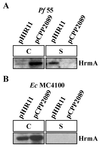The Avr (effector) proteins HrmA (HopPsyA) and AvrPto are secreted in culture from Pseudomonas syringae pathovars via the Hrp (type III) protein secretion system in a temperature- and pH-sensitive manner
- PMID: 10438746
- PMCID: PMC93963
- DOI: 10.1128/JB.181.16.4790-4797.1999
The Avr (effector) proteins HrmA (HopPsyA) and AvrPto are secreted in culture from Pseudomonas syringae pathovars via the Hrp (type III) protein secretion system in a temperature- and pH-sensitive manner
Abstract
We present here data showing that the Avr proteins HrmA and AvrPto are secreted in culture via the native Hrp pathways from Pseudomonas syringae pathovars that produce these proteins. Moreover, their secretion is strongly affected by the temperature and pH of the culture medium. Both HrmA and AvrPto were secreted at their highest amounts when the temperature was between 18 and 22 degrees C and when the culture medium was pH 6.0. In contrast, temperature did not affect the secretion of HrpZ. pH did affect HrpZ secretion, but not as strongly as it affected the secretion of HrmA. This finding suggests that there are at least two classes of proteins that travel the P. syringae pathway: putative secretion system accessory proteins, such as HrpZ, which are readily secreted in culture; and effector proteins, such as HrmA and AvrPto, which apparently are delivered inside plant cells and are detected in lower amounts in culture supernatants under the appropriate conditions. Because HrmA was shown to be a Hrp-secreted protein, we have changed the name of hrmA to hopPsyA to reflect that it encodes a Hrp outer protein from P. syringae pv. syringae. The functional P. syringae Hrp cluster encoded by cosmid pHIR11 conferred upon P. fluorescens but not Escherichia coli the ability to secrete HopPsyA in culture. The use of these optimized conditions should facilitate the identification of additional proteins traveling the Hrp pathway and the signals that regulate this protein traffic.
Figures







References
-
- Alfano J R, Bauer D W, Milos T M, Collmer A. Analysis of the role of the Pseudomonas syringae pv. syringae HrpZ harpin in elicitation of the hypersensitive response in tobacco using functionally nonpolar hrpZ deletion mutants, truncated HrpZ fragments, and hrmA mutations. Mol Microbiol. 1996;19:715–728. - PubMed
-
- Alfano J R, Kim H-S, Delaney T P, Collmer A. Evidence that the Pseudomonas syringae pv. syringae hrp-linked hrmA gene encodes an Avr-like protein that acts in an hrp-dependent manner within tobacco cells. Mol Plant-Microbe Interact. 1997;10:580–588. - PubMed
Publication types
MeSH terms
Substances
LinkOut - more resources
Full Text Sources
Other Literature Sources

